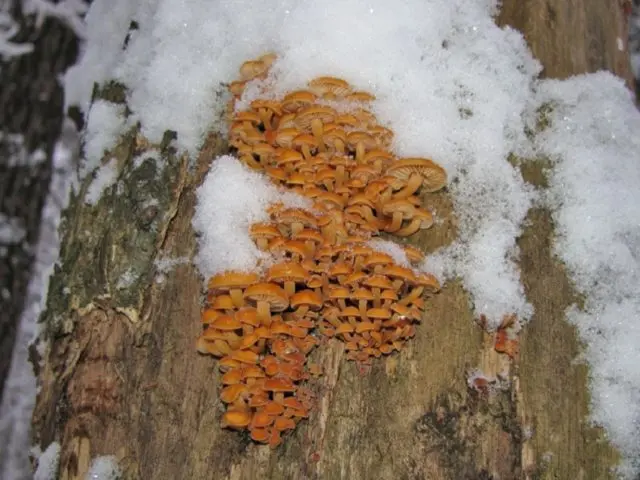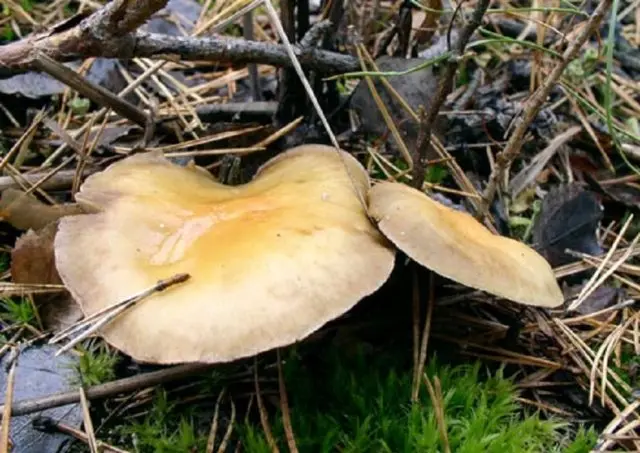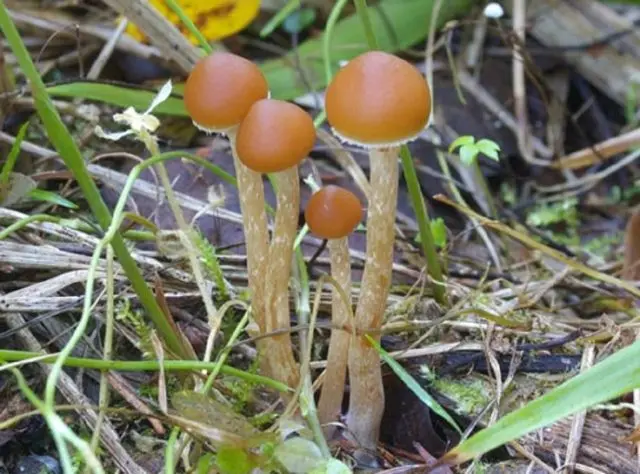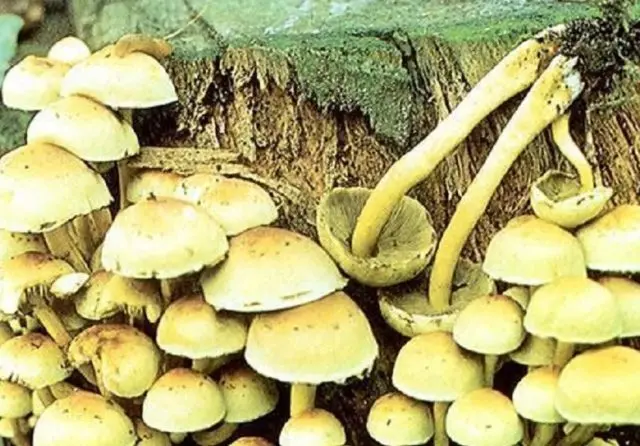Contents
Honey mushrooms in the Kuban are a very common type of mushroom. They grow almost throughout the territory, bear fruit until frost. Depending on the species, mushroom pickers feast on them from April to early March. In order not to gain false varieties, you must first familiarize yourself with useful information. Especially for newbies.

Types of edible mushrooms in the Kuban
Kuban is rich in mushroom catch. There are a lot of honey mushrooms among the varieties. They differ in the season of collection, appearance, places of growth. Kuban mushrooms can be divided into several categories:
- Summer. The Latin name is Kuehneromyces mutabilis. They are classified in the scientific community as Agaricomycetes. At the beginning they have a convex cap, which then becomes flat with a characteristic tubercle in the middle. In the rain it becomes brown and is well translucent. When it gets dry, the surface of the cap is lighter and matte. The edges are framed by distinct grooves, sometimes concentric rings protrude. They are edible species.

- Autumn. The Latin name is Armillariamellea. The second name is real or ordinary. Mycologists attribute the species to parasitic mushrooms, but autumn mushrooms in the Kuban are very tasty. Therefore, mushroom pickers do not remember such a classification. Grows on tree trunks in large colonies. Single specimens are almost never found. The pulp is dense with a persistent mushroom smell. The hat is flat, 5 cm in diameter and with jagged edges. The stem is darker than the cap, the general background is brown.

- Winter or Latin Flammulinavelutipes. The Kuban is rich in winter species, which mushroom pickers collect throughout February. The taste and smell of winter mushrooms depends on where they grow. Mushrooms growing on deciduous trees have a more delicate taste and aroma. Coniferous vegetation gives a slightly bitter taste of resin and a corresponding smell. They tolerate frost well, at this time they simply stop growing.

Most of all, winter mushrooms prefer poplar or maple for settlement.
What honey mushrooms look like in the Kuban
The species belongs in the scientific literature to the Ryadovkovye family. They are small in size with an orange or ocher color. In the Kuban, mushrooms can be distinguished from other mushrooms quite easily by their characteristic external features:
- cap diameter in southern latitudes reaches 3-17 cm;
- the color in the center of the cap is darker;
- the skin of the cap has shades from honey to olive;
- the surface is scaly or rough;
- the view has rare plates;
- in old specimens, the pulp coarsens;
- the legs at the base expand and become darker;
- on the leg there is a ring resembling a skirt;
- the length of the legs of mushrooms in the Kuban reaches 8-10 cm.
External and taste differences are due to the place where the fruiting bodies grow. It is necessary to carefully study the signs of edible species so that unusable specimens do not get into the basket
- brick red (Hypholomalateritium);

- poppy (Hypholomacapnoides);

- bordered gallery (Galerina marginata);

- sulfur yellow (Hypholomafasciculare).

This is due to the fact that old mushrooms also often do not have a ring, like poisonous ones.
A little about the varieties of mushrooms:
Where mushrooms grow in the Kuban
It is important to know the places of growth for all mushroom pickers of the Kuban. This will help you go mushroom picking in the fall of 2021 in the right direction, when the mushrooms in the Kuban begin to bear fruit. The main distribution area is considered to be the foothill and mountainous territories of the Kuban – the vicinity of Laba, Kamyshanovaya Polyana, Arkhyz. Most honey agarics are found in forest clearings, where there are fallen tree trunks or stumps. Autumn species can be found in pine forests. In any case, they prefer moist damp plantings.
The most mushroom places in the Kuban, where you should go for mushrooms:
- Summer and autumn grow in the Arkhyz (Hot Key) area, between Krasnaya Polyana and Kardyvach Lake.
- The Seversky region, Krymsky, Apsheronsky, Belorechensky, and the environs of Barabinsk are considered productive.
- Large growths are found in the Kuban in the Afips valley, near Tuapse and near Gelendzhik.
When honey mushrooms go to the Kuban
To harvest a good harvest of mushrooms, it is not enough to know where they grow. You also need to be aware of the timing. Summer ones are harvested from the second half of August until October. The more southern part of the Krasnodar Territory begins harvesting in June. When autumn comes to the Kuban, mushrooms should be sought from early September until frost. In the more southern regions, the “quiet hunting” season begins in August. Mass fruiting occurs in September. Winter ones are not hard to find. They stand out well against the snowy background. Mushroom pickers note that the taste of winter mushrooms is slightly inferior to summer-autumn counterparts. But on the other hand, you can collect fruiting bodies in December, January and February. If the temperature falls below 0 °C, the fungi stop growing. As soon as warming occurs, they reappear.
Collection rules
Mushroom pickers need to save the mycelium so that the mushrooms can grow again. This will help the observance of the basic rules for collecting fruiting bodies:
- Fruiting bodies are cut, not pulled out. You can unscrew it if you want to avoid contact of the fungus with the metal. This method is more preferable.
- The hat is immediately cleaned of debris and placed in a basket on its side or hat down.
- Select young specimens.
- Mushrooms are looked for in old forests, especially there are a lot of them in plantings over 30 years old.
- It is recommended to collect in a basket, not in buckets. This will keep the mushrooms fresh longer.
How to find out if mushrooms appeared in the Kuban
There are mushroom years and non-mushroom years. This is the name of the season in which there is almost no rain and humidity. It is necessary to start collecting mushrooms in the Kuban when warm, rainy weather sets in. Moist soil is ideal for sprouting mycelium. After a good rain, after 5-6 days you need to move out for a “quiet hunt”.

A good guide for a mushroom picker will be a fallen tree, a stump overgrown with moss.
Conclusion
Honey mushrooms in the Kuban can be collected all season. It is necessary to familiarize yourself with the external parameters of mushrooms, find out the most mushroom places and the timing of fruiting. Such information will help even a beginner to gain a full basket of delicious mushrooms.
















